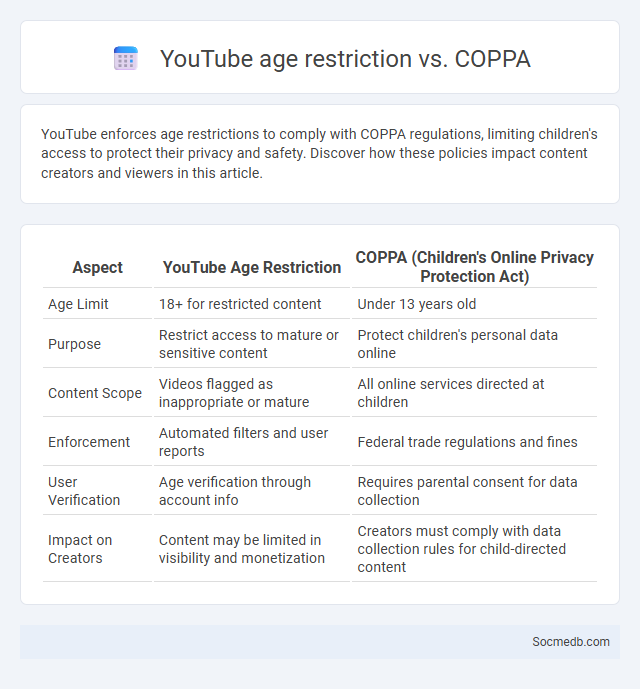
Photo illustration: YouTube age restriction vs COPPA
YouTube enforces age restrictions to comply with COPPA regulations, limiting children's access to protect their privacy and safety. Discover how these policies impact content creators and viewers in this article.
Table of Comparison
| Aspect | YouTube Age Restriction | COPPA (Children's Online Privacy Protection Act) |
|---|---|---|
| Age Limit | 18+ for restricted content | Under 13 years old |
| Purpose | Restrict access to mature or sensitive content | Protect children's personal data online |
| Content Scope | Videos flagged as inappropriate or mature | All online services directed at children |
| Enforcement | Automated filters and user reports | Federal trade regulations and fines |
| User Verification | Age verification through account info | Requires parental consent for data collection |
| Impact on Creators | Content may be limited in visibility and monetization | Creators must comply with data collection rules for child-directed content |
Understanding YouTube Age Restrictions
YouTube age restrictions enforce content access based on users' age to comply with legal requirements and protect younger audiences. These restrictions use account information, device settings, and content ratings to limit exposure to mature videos. Understanding YouTube's age gate system helps creators and viewers navigate content suitability and platform policies effectively.
What Is COPPA and Why Does It Matter?
The Children's Online Privacy Protection Act (COPPA) is a U.S. federal law designed to protect the personal information of children under 13 on social media platforms and websites. It mandates that operators obtain verifiable parental consent before collecting, using, or disclosing personal data from children. Compliance with COPPA is crucial for social media companies to avoid hefty fines and ensure the safety and privacy of young users.
Key Differences: COPPA vs. YouTube Age Restriction
COPPA (Children's Online Privacy Protection Act) regulates the collection of personal information from users under 13, requiring parental consent and limiting data usage on social media platforms. YouTube Age Restriction, by contrast, restricts access to content that is inappropriate for viewers under 18, focusing on content moderation rather than data privacy. Understanding these distinctions helps you ensure compliance when managing social media accounts involving minors.
How YouTube Enforces Age Restrictions
YouTube enforces age restrictions using automated algorithms that detect age-sensitive content and flag videos accordingly. Users must verify their age through Google account information to access restricted videos, ensuring compliance with platform policies and legal regulations. This system helps prevent minors from viewing inappropriate content by combining user data and content analysis.
Legal Implications of COPPA Compliance
COPPA compliance requires social media platforms to implement strict data protection measures for children under 13, ensuring parental consent before collecting personal information. Your social media practices must align with these legal standards to avoid significant fines and reputational damage. Failure to comply exposes your platform to enforcement actions from the Federal Trade Commission (FTC) and potential lawsuits.
Impact on Content Creators
Social media platforms have revolutionized content creation by providing creators with direct access to global audiences, enabling rapid growth and monetization opportunities. Algorithms prioritize engagement metrics, influencing the type and frequency of content produced, often emphasizing short-form, visually appealing posts to maximize reach. As competition intensifies, creators increasingly rely on data analytics and collaboration strategies to maintain relevance and sustain their income streams.
Parental Controls and Viewer Protection
Parental controls on social media platforms empower you to restrict inappropriate content and monitor your child's online activity effectively. Advanced viewer protection features use AI algorithms to detect harmful or misleading content, helping maintain a safe digital environment for younger users. Implementing these tools ensures your family's social media experience remains secure and age-appropriate.
Monetization Challenges: Age Restriction vs. COPPA
Social media platforms face significant monetization challenges due to age restrictions imposed by laws like COPPA, which limits data collection from users under 13. Compliance with COPPA restricts targeted advertising opportunities, reducing potential ad revenue from younger audiences. Balancing user privacy with effective monetization strategies requires platforms to innovate while adhering to strict regulatory frameworks.
Reporting and Appealing Age-Restricted Content
Social media platforms implement strict guidelines and automated systems to identify and restrict age-inappropriate content, ensuring compliance with legal standards such as COPPA and GDPR. Users can report age-restricted content through built-in reporting tools, prompting reviews by content moderators or AI algorithms to evaluate potential violations. Appeals processes offer users the ability to contest restrictions, maintaining transparency and fairness while protecting minors from harmful material.
Best Practices for Navigating Age Policies on YouTube
Understanding YouTube's age policies is crucial for maintaining compliance and ensuring a positive experience on the platform. You should verify age restrictions for content access and use parental controls to protect younger viewers. Following YouTube's guidelines helps avoid account suspension and promotes a safe community environment.
 socmedb.com
socmedb.com